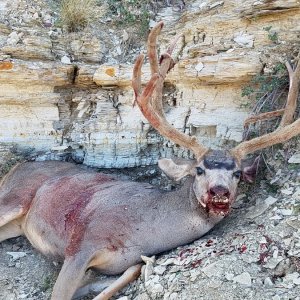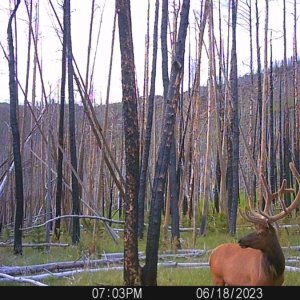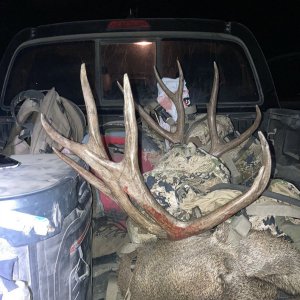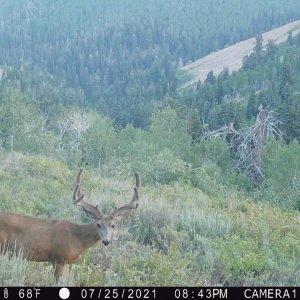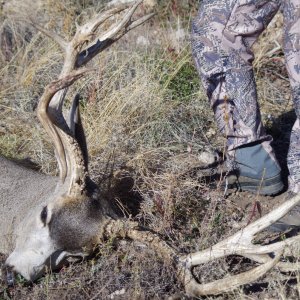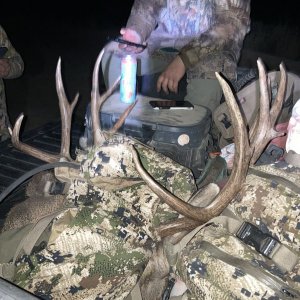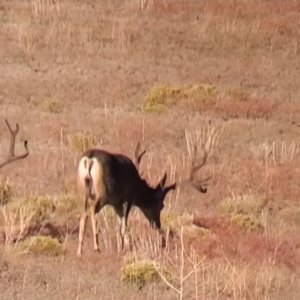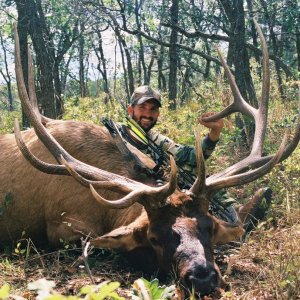I am a gun hunter looking (maybe) at starting to bow hunt. I would like to purchase a bow that I could shoot now as a novice, and also grow into as I progress. Brand name does not matter. Can I buy a bow that I can learn with, and still hunt with in 20 years? mtmuley
You are using an out of date browser. It may not display this or other websites correctly.
You should upgrade or use an alternative browser.
You should upgrade or use an alternative browser.
from gun to bow
- Thread starter mtmuley
- Start date
legacy
Very Active Member
- Messages
- 2,116
If you're serious, don't hesitate to spend some money. A lot of bows will be just as effective in years as they are now. I would save up and spend the money because you will spend a lot more in the future upgrading and buying what you really want if you don't do it now. Even with that said...I wouldn't antcipate using the same bow for twenty years. But if you buy a decent one you could use it for that long if you really wanted to. I shoot a Mathew's and love it. It wasn't cheap, but if I decided I wanted to shoot it for twenty years I could. I really think as a novice you could learn on almost any of the new bows. Find a bow that is not too short axle to axle....more or less one that is a little forgiving. (consider brace height etc...) I'm sold on Mathew's so I would say check out a Legacy or LX. I would consider maybe even finding a used bow. Mtmuley, what area do you live in?
B
Benado
Guest
I also shoot a Mathews. I bought the Legacy 2 years ago and I don't anticipate changing any time soon. As far as growing into the bow, if you're already fully grown a Mathews (or any other bow) will work fine. If you still have some growing to do you better look at bows with draw length adjustments. I imagine there will be some votes for Hoyt bows also. These are very good bows, I just thought the Mathews felt better. Go with what feels good, and by all means save your money for what you consider to be the best bow. In the long run you will actually save money. Like legacy said, if you don't buy exactly what you want, you will continue to up grade until you have your dream set-up. Good luck.
W
Wapitihntr
Guest
I noticed a great deal on ebay today for around $250 bucks. There is a loaded Hoyt Vortec for sale. I shot this type of bow for a few year and you would love it. Great value check it out.
D
DEVIL_DOG
Guest
Can't go wrong with any Hoyt bow. Just my $.o2.
R
roadkill_44
Guest
I bought a Mathews and love it. It is one that will last a long time.
Thanks guys. It sounds like I should head for the archery shop and try some bows. I do have high school friend that owns a shop that may be of help also. I have read a longer brace height is more forgiving. Is this true? And what are some good sights and releases? Thanks again, mtmuley
R
roadkill_44
Guest
I shoot an Mathews Outback, and I believe that it is 31 inches axle to axle, and it is very forgiving and very quiet. I shoot a mongose release, and true glow sites. GOOD LUCK.
txhunter58
Long Time Member
- Messages
- 8,741
A month ago, I didn't even know what a brace height was or what "forgiving" meant. As I understand it, forgiving means not messing with your accuracy too much if you have some minor shooting flaws. I have heard 2 schools of thought of what makes a forgiving bow, and I guess it is a little of both.
First a longer bow tends to be more forgiving probably due to being easier to hold straight vertical.
Second, and this is what I have been told is more important, a decent brace height. The longer the brace height, the more forgiving the bow is. The brace height is essentially the distance between the arrow rest (may not be exactly accurate) and the string when it is not pulled back. Therefore when the sting "releases" the arrow, the further back it is, the easier it is to stablize the arrow and more forgiving it is to an archer who is not perfect with his form. Makes sense to me even though it is all "book knowledge" as I have yet to pick up my new bow and try release shooting for the first time.
That makes it a little hard to decide if one bow is more forgiving than another. For instance, the Outback is 2 inches shorter than the switchback, but it has a slightly longer brace height. I have heard that both bows are pretty forgiving. I have been told to look for at least a 7" brace height.
I did a lot of research and finally settled on a Copper Johns dead Nuts hunter sight. Wanted to get a Spot Hogg, but couldn't see spending that much money on a sight. Heard lots of good things about the dead nuts, and it is only $50-80 depending on the model. I have also heard to get the 0.29 fiberoptics, not the smaller ones for hunting due to the 0.19 pins breaking in brush easier.
I also opted for the whisker bisquit (relatively inexpensive and much lauded as a hunting rest by those who use it) and Gold tip arrows. Lots of good rests and arrows out there though.
txhunter58
venor, ergo sum (I hunt, therefore I am)
First a longer bow tends to be more forgiving probably due to being easier to hold straight vertical.
Second, and this is what I have been told is more important, a decent brace height. The longer the brace height, the more forgiving the bow is. The brace height is essentially the distance between the arrow rest (may not be exactly accurate) and the string when it is not pulled back. Therefore when the sting "releases" the arrow, the further back it is, the easier it is to stablize the arrow and more forgiving it is to an archer who is not perfect with his form. Makes sense to me even though it is all "book knowledge" as I have yet to pick up my new bow and try release shooting for the first time.
That makes it a little hard to decide if one bow is more forgiving than another. For instance, the Outback is 2 inches shorter than the switchback, but it has a slightly longer brace height. I have heard that both bows are pretty forgiving. I have been told to look for at least a 7" brace height.
I did a lot of research and finally settled on a Copper Johns dead Nuts hunter sight. Wanted to get a Spot Hogg, but couldn't see spending that much money on a sight. Heard lots of good things about the dead nuts, and it is only $50-80 depending on the model. I have also heard to get the 0.29 fiberoptics, not the smaller ones for hunting due to the 0.19 pins breaking in brush easier.
I also opted for the whisker bisquit (relatively inexpensive and much lauded as a hunting rest by those who use it) and Gold tip arrows. Lots of good rests and arrows out there though.
txhunter58
venor, ergo sum (I hunt, therefore I am)
B
bowhuntingboy
Guest
I would recommend the Copper John Dead Nuts. I payed $65 for the 5 sight model over at Sportsman's warehouse. It's a great site for the little money that it costs. I know you didnt mention any rests, but I would recomend the trophy taker or the trophy ridge drop zone. Both great rests.
~Bowhuntingboy
~Bowhuntingboy
W
Warren
Guest
There is nothing like making a kill shot with your bow. I shot a Darton for ten years. Picked up a Matthews and it was from another world. I love my Matthews. You will hear a lot of tech talk. Get your friend to set you up with a bow and shoot it. If he does his job, it will shoot well. It is a lot of fun to practice with.
Thanks again guys. Had some computer problems, so haven't been able to log on for a few days. I have a lot of buds that bowhunt, and they say I am missing something. I did tag along with a friend on a few elk bowhunts last year, and was amazed at the difference from packing a rifle. So much more awareness of sounds, sights, and animals. I think I'll give it a try. mtmuley
txhunter58
Long Time Member
- Messages
- 8,741
And the nice thing about Montana (as is the case in Texas too) is that you can hunt archery season, and if you don't punch your tag, you can still hunt in gun season. Not so in most western states! Truly a hunters paradise.
txhunter58
venor, ergo sum (I hunt, therefore I am)
txhunter58
venor, ergo sum (I hunt, therefore I am)
B
bigmo101
Guest
mtmuley,
I've been hunting for about 6 years with a bow. I've nailed a few animals with a bow and to be honest with you the best thing to do is get a long axle to axle bow and a 7" or above brace height. This is of course if you're hunting spot and stalk. Don't get caught up in all the hype by companies. Go into a pro shop and try different bows and see what you think. The bow should feel good to you. I shot a Mathews Q2 for about 5 years and then recently switched to a Bowtech Old Glory. If you don't want to spend the money so soon, you will after shooting for about 6 months. I guess the main question is, will you stick with it? Just remember, forgiveness kills, not speed.
I've been hunting for about 6 years with a bow. I've nailed a few animals with a bow and to be honest with you the best thing to do is get a long axle to axle bow and a 7" or above brace height. This is of course if you're hunting spot and stalk. Don't get caught up in all the hype by companies. Go into a pro shop and try different bows and see what you think. The bow should feel good to you. I shot a Mathews Q2 for about 5 years and then recently switched to a Bowtech Old Glory. If you don't want to spend the money so soon, you will after shooting for about 6 months. I guess the main question is, will you stick with it? Just remember, forgiveness kills, not speed.
B
bittersweetmuleymeat
Guest
Being an archery hunter myself, and having guided archery hunters for near 20 years the ONLY reccomendation I would have would be use the simplest setup you can shoot with effectively. If you need a peep and a release and a battlestar gallactica 23 pin sight, utilize them. If you can shoot effectively with a simpler setup, do.
Dont just assume you need your bow decked out from top to bottom with accesories. The more peices there is to your bow, the more things that can fail you in the field. (and they will) Practice alot and get by with as little as you can. If you need a complicated setup to shoot effectively, you owe it to the game to utilize those things, have fun!
Dont just assume you need your bow decked out from top to bottom with accesories. The more peices there is to your bow, the more things that can fail you in the field. (and they will) Practice alot and get by with as little as you can. If you need a complicated setup to shoot effectively, you owe it to the game to utilize those things, have fun!
R
rooselk
Guest
When making the transition from a gun to a bow it is undoubtedly easier to learn to shoot a compound (or so I've been told many times - though I believe it's true). About a year or so ago I too decided to switch from a rifle in favor of a bow despite the fact I had absolutely zero experience in archery. But after visiting a couple of archery shops and trying a compound in the store I decided it just wasn't for me. Instead, I opted for simplicity and purchased a 50# Martin Savannah longbow. Admittedly it's taken me longer to learn to shoot this style bow than it would have a compound, but I've had nothing but fun since making the purchase.
I have nothing against compounds: they have a lot going for them - they're just not my preference. A traditional bow is just simpler than a compound in that there is less to go wrong whith the bow while in the field. Moreover, I have since met guys that have recurves they've shot since the 1960's. With all the moving parts on a compound I doubt that there are many guys who still shoot the same compound they bought twenty or thirty years ago. On the other hand a good stickbow, with care, will last a lifetime.
Just my 2 cents. Have fun and good luck.
I have nothing against compounds: they have a lot going for them - they're just not my preference. A traditional bow is just simpler than a compound in that there is less to go wrong whith the bow while in the field. Moreover, I have since met guys that have recurves they've shot since the 1960's. With all the moving parts on a compound I doubt that there are many guys who still shoot the same compound they bought twenty or thirty years ago. On the other hand a good stickbow, with care, will last a lifetime.
Just my 2 cents. Have fun and good luck.
F
foxtrot4elk
Guest
mtmuley,looks like you have been getting lots of good advice so I won't belabor you with more.
Just wanted you to know that I started bowhunting as a "season extension". Figured if I was out there scouting in Sept. I might as well have a "chance" at one too.
The thought of giving up rifle hunting for elk,at the time was absurd to me.Little did I know that though I was already addicted to hunting, the 1st day I entered the woods after elk with a bow I was to have more close up encounters and massive flows of adrenalin in 1 season than I had in my whole life of rifle hunting!!
Although I still hunt deer w/a rifle & do hunt elk in the late season with my muzzleloader,I am consumed with bow hunting elk. Since Idaho went to A & B tags for elk my rifle has been left behind. I really haven't missed it a bit.
Get ready for a hell of a fun time!
foxtrot4elk
Just wanted you to know that I started bowhunting as a "season extension". Figured if I was out there scouting in Sept. I might as well have a "chance" at one too.
The thought of giving up rifle hunting for elk,at the time was absurd to me.Little did I know that though I was already addicted to hunting, the 1st day I entered the woods after elk with a bow I was to have more close up encounters and massive flows of adrenalin in 1 season than I had in my whole life of rifle hunting!!
Although I still hunt deer w/a rifle & do hunt elk in the late season with my muzzleloader,I am consumed with bow hunting elk. Since Idaho went to A & B tags for elk my rifle has been left behind. I really haven't missed it a bit.
Get ready for a hell of a fun time!
foxtrot4elk

